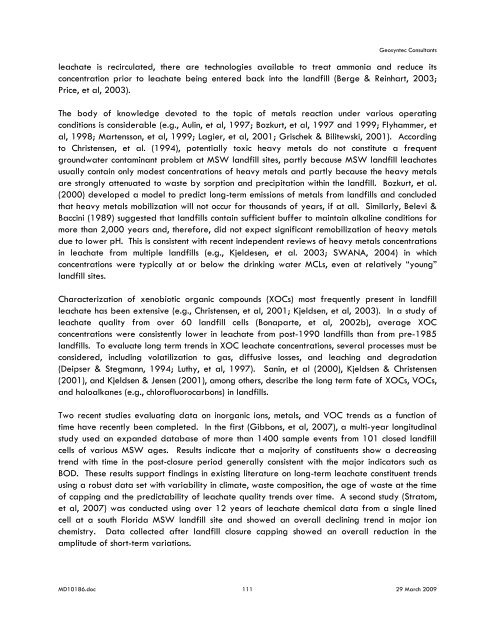AREA A/B ENGINEERING REPORT - Waste Management
AREA A/B ENGINEERING REPORT - Waste Management
AREA A/B ENGINEERING REPORT - Waste Management
Create successful ePaper yourself
Turn your PDF publications into a flip-book with our unique Google optimized e-Paper software.
Geosyntec Consultants<br />
leachate is recirculated, there are technologies available to treat ammonia and reduce its<br />
concentration prior to leachate being entered back into the landfill (Berge & Reinhart, 2003;<br />
Price, et al, 2003).<br />
The body of knowledge devoted to the topic of metals reaction under various operating<br />
conditions is considerable (e.g., Aulin, et al, 1997; Bozkurt, et al, 1997 and 1999; Flyhammer, et<br />
al, 1998; Martensson, et al, 1999; Lagier, et al, 2001; Grischek & Bilitewski, 2001). According<br />
to Christensen, et al. (1994), potentially toxic heavy metals do not constitute a frequent<br />
groundwater contaminant problem at MSW landfill sites, partly because MSW landfill leachates<br />
usually contain only modest concentrations of heavy metals and partly because the heavy metals<br />
are strongly attenuated to waste by sorption and precipitation within the landfill. Bozkurt, et al.<br />
(2000) developed a model to predict long-term emissions of metals from landfills and concluded<br />
that heavy metals mobilization will not occur for thousands of years, if at all. Similarly, Belevi &<br />
Baccini (1989) suggested that landfills contain sufficient buffer to maintain alkaline conditions for<br />
more than 2,000 years and, therefore, did not expect significant remobilization of heavy metals<br />
due to lower pH. This is consistent with recent independent reviews of heavy metals concentrations<br />
in leachate from multiple landfills (e.g., Kjeldesen, et al. 2003; SWANA, 2004) in which<br />
concentrations were typically at or below the drinking water MCLs, even at relatively “young”<br />
landfill sites.<br />
Characterization of xenobiotic organic compounds (XOCs) most frequently present in landfill<br />
leachate has been extensive (e.g., Christensen, et al, 2001; Kjeldsen, et al, 2003). In a study of<br />
leachate quality from over 60 landfill cells (Bonaparte, et al, 2002b), average XOC<br />
concentrations were consistently lower in leachate from post-1990 landfills than from pre-1985<br />
landfills. To evaluate long term trends in XOC leachate concentrations, several processes must be<br />
considered, including volatilization to gas, diffusive losses, and leaching and degradation<br />
(Deipser & Stegmann, 1994; Luthy, et al, 1997). Sanin, et al (2000), Kjeldsen & Christensen<br />
(2001), and Kjeldsen & Jensen (2001), among others, describe the long term fate of XOCs, VOCs,<br />
and haloalkanes (e.g., chlorofluorocarbons) in landfills.<br />
Two recent studies evaluating data on inorganic ions, metals, and VOC trends as a function of<br />
time have recently been completed. In the first (Gibbons, et al, 2007), a multi-year longitudinal<br />
study used an expanded database of more than 1400 sample events from 101 closed landfill<br />
cells of various MSW ages. Results indicate that a majority of constituents show a decreasing<br />
trend with time in the post-closure period generally consistent with the major indicators such as<br />
BOD. These results support findings in existing literature on long-term leachate constituent trends<br />
using a robust data set with variability in climate, waste composition, the age of waste at the time<br />
of capping and the predictability of leachate quality trends over time. A second study (Stratom,<br />
et al, 2007) was conducted using over 12 years of leachate chemical data from a single lined<br />
cell at a south Florida MSW landfill site and showed an overall declining trend in major ion<br />
chemistry. Data collected after landfill closure capping showed an overall reduction in the<br />
amplitude of short-term variations.<br />
MD10186.doc 111 29 March 2009

















